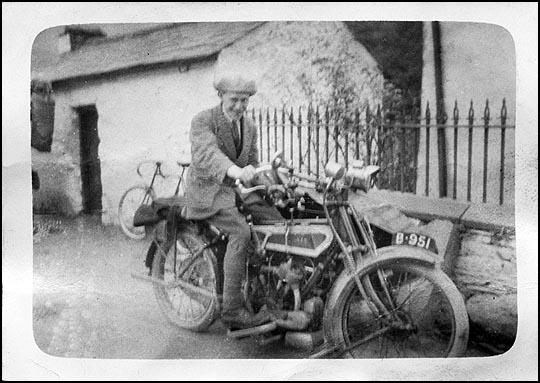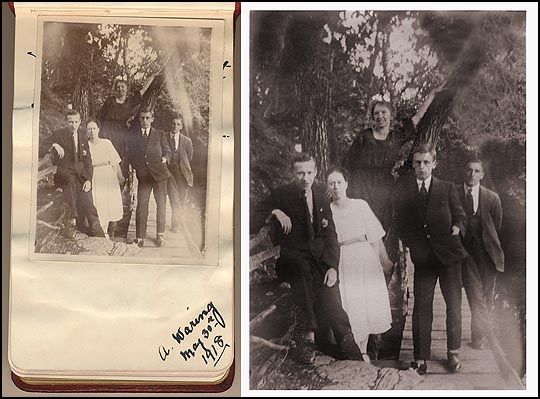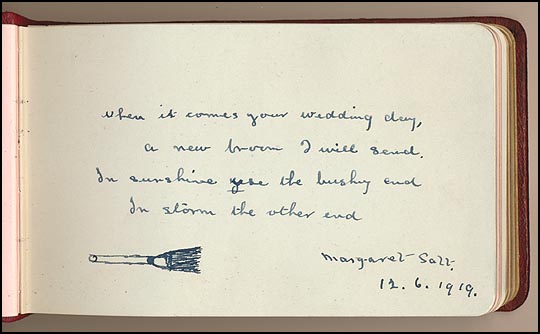Yes I know I've been a bit (a bit???) quiet on the blog this year. But this may go some way as to explain why. For some time I've been producing my pencil sketches a few every year, mainly done whilst on holiday. Last year I tried a couple of water colours over the top of existing sketches. I was fancying having a go at something more spectacular and challenging.

And this is it. An oil pastel painting based on a photograph of Villefranche which lies between Nice and Monaco on the French Mediterranean coast. There was a certain amount of preparatory work for this. I had no easel. I had no pastels... And to make it worthwhile it had to be done on a larger scale than anything I've attempted before. So the bits and pieces of equipment and pastel sticks were bought and a pad of pristine white paper in an A2 size sketch pad. I started work on the 24 January 2017 and finished yesterday morning on 3 March 2017. Not that I've worked eight hours a day every day, though... I've stuck little bits on my FaceBook account as I've been going along and a friend suggested I should collate them into an article. So this is it...
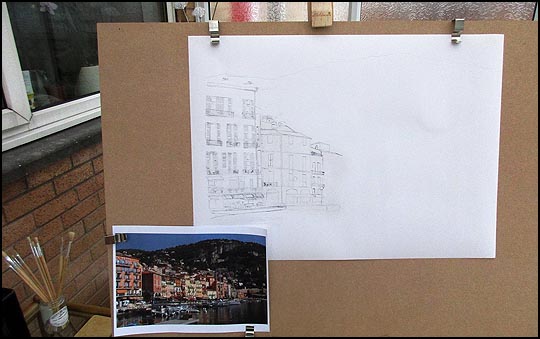
24 January 2017. The easel and paper is set up in the conservatory which will give me enough light to work with. I had been wanting to draw a colour sketch of Villefranche for some time so trawling through my photos of various visits over the years I printed one out onto A4 paper and used that as a guide. At this stage there was no real anticipation of producing anything wonderful and I didn't really think I'd be able to fit a load of detail in using pastels, but drew my usual style of pencil sketch anyway, but without any shading or detail such as foliage.

29 January 2017. This being the equivalent of four A4 sheets, there was no way of scanning it so I had to take photos of each stage. Whilst it was in the pure black and white (or grey of pencil) stage this meant I had to tweak the photo quite a bit to bring out the detail at the expense of the paper going dark and looking dirty! It took five days to get to this stage. A lot of the work got done in five minute bursts whilst I was waiting for the kettle to boil... Even as just a pencil sketch, this was still the largest thing I've ever done and I was starting to realise that I didn't want to spoil it!

3 February 2017. Very little had happened this week in fact, as other things were going on that took my attention. I had decided that I was going to use the pastels even though I might lose detail and to test this out a bit I started with the orange building on the left hand side. I tried it out on a piece of A4 paper first to gauge my technique and adjust if necessary. I bought a set of blending sticks which looked a bit like paintbrushes, but with rubber (like pencil erasers) instead of bristles at the end. I was also trying out techniques for the sky area. The first go was a real mess and I bought a cheap book on painting with pastels and tried out on another sheet of paper the techniques they described.

4 February 2017. After a couple of goes on an A4 sheet - one good, one bad - I thought "What the heck!" and went for it. I also tried out an area of distant hillside and a tiny building in the distance.
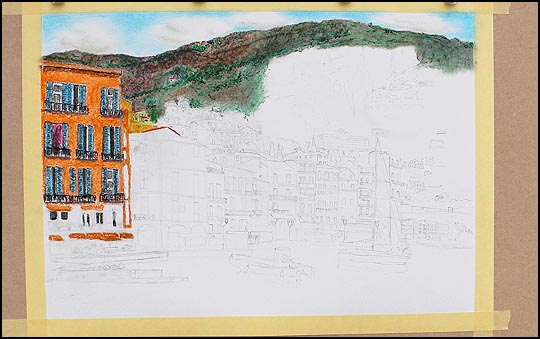
5 February 2017. I spent the morning adding in defining details to the upper storeys of the orange building and then tackled mountainside. The latter also has a few small buildings here and there. That was it for the day as we'd been invited out to celebrate a 60th birthday. Next steps will be to complete the background and do the cliffs towards the right-hand side. That was going to be another suck-it-and-see test on a fresh piece of paper before committing to the actual painting. I found that small items such as roofs and windows on the background buildings were best done with a tiny smudge of colour and then using one of the blending tools. For thin black lines I chose a blending tool shaped like a paintbrush and applied minute bits of paint by rubbing the blender on the top of the stick of pastel. I got enough pigment to do a millimetre at a time, two at the most. The hillside was done using brown and two shades of green and drawing intersecting wavy lines before blending the colours with my finger. Over on the left hand side a dark red was also added to the mix.

9 February 2017. A close up of the detail in the top left corner. Yet a third shade of green was used quite thickly to suggest trees and foliage. A bit tentatively at first with a couple of lines to suggest footpaths or roads along the mountainside, but then the yellow building got done and the cypress trees at the side of it and they were a sort of happy stumbling on something that made me use that shade quite a lot afterwards for trees and foliage!

11 February 2017. My FaceBook update went: I did quite a bit yesterday and have added to it today, but now getting ready to go hospital visiting and as it's half-term next week and we will have Grace a few days it might have to go upstairs out of the way! More hillside done, more trees and foliage added. A few more buildings done - I learned the hard way you can't mix colours easily. I'm sure you'll be able to spot where I found this out... Lower storeys of the orange building started and the car which Miss Franny said had to be blue. Suspicious now... I've never had that blue a car...

13 February 2017. I spent the previous day on the left hand side, working towards the lower part of the painting. The sea was going to be left until the very end. For one thing it was going to be complicated and needed a lot of layering of colours which I wasn't too sure of as yet. And for another, I suspected it may have to be done as one complete portion to avoid any obvious vertical breaks that might occur if I attempted t do it bit by bit. And for a third and final thing - proving that you can start two consecutive sentences with the word "and" - I always work top left to bottom right so that my hand doesn't smudge bits I've already done. I wasn't yet ready to make myself a long dowel with a small bean bag on the end to act as a hand rest whilst painting over bits already done.
Today I took a very deep breath and headed for the cliffs. One of those "this could ruin it" moments. I used grey and a dark ochre and smeared them together vertically, using the ochre to suggest soil seeping from ledges. I figured they were too far in the distance to start drawing cracks in the rockface so instead used small amounts of black to suggest the shadows caused by clefts and breaks in strata. Adding foliage along the ledges helped the illusion. I was not particularly keen on the far-too-pink building and friends agreed, with one suggesting it stood out like "a dog's..." well, never mind... I will see if I can tone it down any! Half Term starts and I move the easel upstairs for a week where it won't get knocked over accidentally.

21 February 2017. It's back downstairs and being worked. I have to hold my hand up and admit I never expected to manage this amount of detail. The sea still awaits to trip me up though. And the windows and shutters are getting smaller all the time now... I put a darker red pigment over the pink and managed to tone it down a bit.
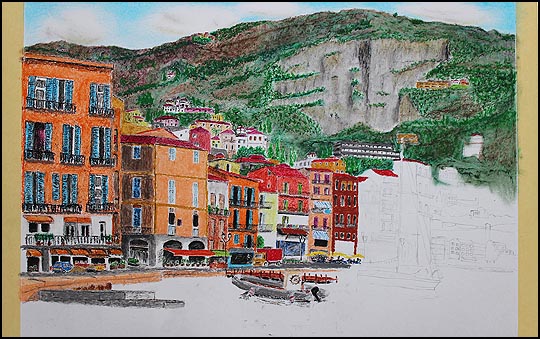
25 February 2017. By now I was spending more time on it each day as it was starting to get quite exciting! Each time it's noticeable that the white untouched area is shrinking. A couple more foreground buildings to the right, another swathe of hillside and the large building - university, school or just apartments? - done. At the bottom, the sea wall extended and I swapped some concrete for a more picturesque Lake District style wooden jetty. Well they should have done it proper in the first place... The inflatable boat has been done and I gave a huge sigh of relief afterwards I can tell you! It will probably need a bit of tidying after the sea goes round it. And that's another serious psyching-up moment to come!

28 February 2017. The previous three days saw me just about reach a landmark. The next mark will be a seamark! The last few hotels have been done, the remaining buildings on the hillside and what looks like the old town walls at the right hand side (in the real Villefranche they support the railway!) had me trying a new technique for blending colours. I found it very hard to get a suggestion that it was made from large blocks of stone... Now the sea beckons and I need to experiment on fresh paper to get a technique for mixing horizontal splashes of colour for the sea with the verticals of the reflected colours of buildings etc. I commented on FaceBook "The next time you see it, I will either have finished or ripped it up and you will see it in the bin..." I'm pleased to say a number of people begged me not to rip it up!
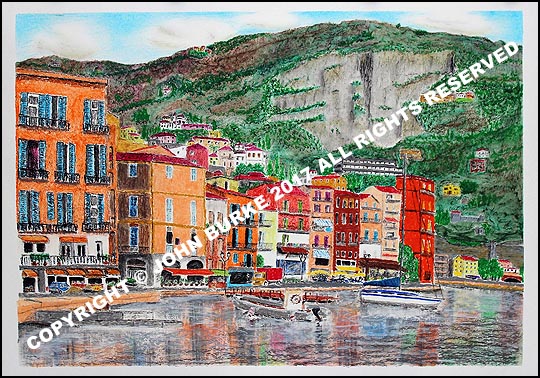
3 March 2017. Sorry about the copyright notice, but despite the copyright notice already on this blog to the left it is absolutely amazing how many times my photos from this blog turn up without people having the courtesy to mention where they came from. I allow use for non-profit purposes but ask that I am credited. Most people now assume copyright doesn't matter, I've even had someone suggest I was deliberately spoiling his book by refusing to allow him to simply copy the tiny photo on here for a book without any consideration and he dismissed my suggestion that I would need to provide a large scan and then clean it up because old negatives and slides will be dirty. Duh... The Internet works at 72 dots per inch. Books work at least at 600 dots per inch. If you just lift an image for a book off here you could hope to get a good quality image if it was printed no more than half an inch wide. In the end after I refused, he protested that he was going to offer me a discount off his book (it was going to sell priced around £40!!!) Anyway, please bear in mind that I spent the 1980s and 90s freelancing to magazines. My photos were taken when it cost money to take photos and they were taken with the intention of selling them. So sorry about the copyright notice over the pic and the slight rant...
I had been seriously driving myself nuts about starting the sea area. I did a Google search for pastel paintings water reflections video and watched a few to see how people had done them. There are some really good videos about to help artists. So on the 2nd of March at tea time I started drawing horizontal lines of colour onto the sea area. The colours were all of those that would appear reflected from the relevant area above the waterline and positioned where I thought the top of the reflection would start. I ended up with a mess of horizontal lines of colour, lots of white space and my heart in my mouth.
Then where I had room, I used a finger and smeared downwards to the bottom of the paper. An artist friend - I'm going to name her, Christine (Katie) Astbury - gave me loads of help through private messages over FaceBook all the way through this artwork and never protested or dodged any of the naive and sometimes complex questions I fired at her, thank you xxx
Where I didn't have room to use my finger to smear the colour such as in the angles of sea wall and jetty, Katie suggested using cotton buds and that worked a treat. So now I had some quite vivid stripes of colour which looked rather startling. I had to tone them down and then make it appear as though they were reflections on water. I toned them down by scraping vertically downwards with a palette knife which took off quite a bit of pigment, smoothed out any lumps and gave me a fresh working surface to work on the water - as it were. This was achieved using three shades of grey, a silver-blue, a mid and a dark grey to create both short horizontal lines and random wavy lines but only straying from the horizontal a little. The dark grey was used to darken areas of deeper water away from the sea wall. Some white was added to suggest spray or eddies of water around the boats and the sea wall.
I started this as an experiment and never expected to end up with something like this. I'm every bit as flabbergasted as anyone else has professed to be. But quite pleased... My son-in-law has brought me a couple of sets of oil paints and brushes. Miss Franny is looking at the conservatory floor and looking pensive...
Return to Sketching and Artwork Index







